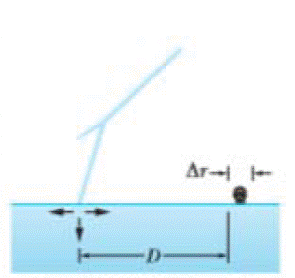Problem 1Q: Figure 26-15 shows cross sections through three long conductors of the same length and material,... Problem 2Q: Figure 26-16 shows cross sections through three wires of identical length and material; the sides... Problem 3Q: Figure 26-17 shows a rectangular solid conductor of edge lengths L, 2L, and 3L. A potential... Problem 4Q: Figure 26-18 shows plots of the current i through a certain cross section of a wire over four... Problem 5Q: Figure 26-19 shows four situations in which positive and negative charges move horizontally and... Problem 6Q: In Fig. 26-20, a wire that carries a current consists of three sections with different radii. Rank... Problem 7Q: Figure 26-21 gives the electric potential Vx versus position x along a cooper wire carrying current.... Problem 8Q: The following table give the lengths of three copper rods, their diameters, and the potential... Problem 9Q Problem 10Q: Three wires, of the same diameter, are connected in turn between two points maintained at a constant... Problem 11Q: Figure 26-23 gives, for three wires of radius R, the current density Jr versus radius r, as measured... Problem 1P: During the 4.0 min a 5.0 A current is set up in a wire, how many a coulombs and b electrons pass... Problem 2P: An isolated conducting sphere has a 10 cm radius. One wire carries a current of 1.000 002 0 A into... Problem 3P: A charged belt, 50 cm wide, travels at 30 m/s between a source of charge and a sphere. The belt... Problem 4P: The United States National Electric Code, which sets maximum safe currents for insulated copper... Problem 5P: SSM WWW A beam contains 2.0 108 doubly charged positive ions per cubic centimeter, all of which are... Problem 6P: A certain cylindrical wire carries current. We draw a circle of radius r around its central axis in... Problem 7P: A fuse in an electric circuit is a wire that is designed to melt, and thereby open the circuit, if... Problem 8P Problem 9P: The magnitude Jr of the current density in a certain cylindrical wire is given as a function of... Problem 10P: The magnitude J of the current density in a certain lab wire with a circular cross section of radius... Problem 11P: What is the current in a wire of radius R = 3.40 mm if the magnitude of the current density is given... Problem 12P: Near Earth, the density of protons in the solar wind a stream of particles from the Sun is 8.70 cm3,... Problem 13P Problem 14P: A human being can be electrocuted if a current as small as 50mA passes near the heart. An... Problem 15P: SSM A coil is formed by winding 250 turns of insulated 16-gauge copper wire diameter = 1.3 mm in a... Problem 16P: Copper and aluminium are being considered for a high-voltage transmission line that must carry a... Problem 17P Problem 18P: A wire 4.00 m long and 6.00 mm in diameter has a resistance of 15.0 m. A potential difference of... Problem 19P: SSM What is the resistivity of a wire of 1.0 mm diameter, 2.0 m length, and 50 m resistance? Problem 20P Problem 21P: ILW A common flashlight bulb is rated at 0.30 A and 2.9 V the values of the current and voltage... Problem 22P: Kiting during a storm. The legend that Benjamin Franklin flew a kite as a storm approached is only a... Problem 23P Problem 24P: GO Figure 26-25a gives the magnitude Ex of the electric fields that have been set up by a battery... Problem 25P: SSM ILW A wire with a resistance of 6.0 is drawn out through a die so that its new length is three... Problem 26P: In Fig. 26-26a. a 9.00 V battery is connected to a resistive strip that consists of three sections... Problem 27P: SSM WWW Two conductors are made of the same material and have the same length. Conductor A is a... Problem 28P: GO Figure 26-27 gives the electric potential Vx along a copper wire carrying uniform current, from a... Problem 29P Problem 30P Problem 31P Problem 32P Problem 33P Problem 34P: GO Figure 26-29 shows wire section 1 of diameter D1 = 4.00R and wire section 2 of diameter D2 =... Problem 35P: GO In Fig. 26-30, current is set up through a truncated right circular cone of resistivity 731 m,... Problem 36P: GO Swimming during a storm. Figure 26-31 shows a swimmer at distance D = 35.0 m from a lightning... Problem 37P Problem 38P: In Fig. 26-32a, a 20 resistor is connected to a battery. Figure 26-32b shows the increase of... Problem 39P: A certain brand of hot-dog cooker works by applying a potential difference of 120 V across opposite... Problem 40P: Thermal energy is produced in a resistor at a rate of 100 W when the current 3.00 A. What is the... Problem 41P: SSM A 1220 V potential difference is applied to a space heater whose resistance is 14 when hot. a... Problem 42P: In Fig. 26-33, a battery of potential difference V = 12 V is connected to a resistive strip of... Problem 43P: ILW An unknown resistor is connected between the terminals of a 3.00 V battery. Energy is dissipated... Problem 44P: A student kept his 6.0 V, 7.0 W radio turned on at full volume from 9:00 P.M. until 2:00 A.M. How... Problem 45P: SSM ILW A 1250 W radiant heater is constructed to operate at 115 V. a What is the current in the... Problem 46P: A copper wire of cross-sectional area 2.00 106 m2 and length 4.00 m has a current of 2.00 A... Problem 47P: A heating element is made by maintaining a potential difference of 75.0 V across the length of a... Problem 48P: Exploding shoes. The rain-soaked shoes of a person may explode if ground current from nearby... Problem 49P: A 100 W lightbulb is plugged into a standard 120 V outlet. a How much does it cost per 31-day month... Problem 50P: GO The current through the battery and resistors 1 and 2 in Fig. 26-34a is 2.00 A. Energy is... Problem 51P: GO SSM WWW Wire C and wire D are made from different materials and have length LC = LD = 1.0 m. The... Problem 52P: GO The current-density magnitude in a certain circular wire is J = 2.75 1010 A/m4r2, where r is the... Problem 53P: A 120 V potential difference is applied to a space heater that dissipates 500 W during operation. a... Problem 54P: Go Figure 26-36a shows a rod of resistive material. The resistance per unit length of the rod... Problem 55P: SSM A Nichrome heater dissipates 500 W when the applied potential difference is 110 V and the wire... Problem 56P Problem 57P: An 18.0 W device has 9.00 V across it. How much charge goes through the device in 4.00 h? Problem 58P: An aluminum rod with a square cross section is 1.3 m long and 5.2 mm on edge. a What is the... Problem 59P: A cylindrical metal rod is 1.60 m long and 5.50 mm in diameter. The resistance between its two ends... Problem 60P: The chocolate crumb mystery. This story begins with Problem 60 in Chapter 23 and continues through... Problem 61P: SSM A steady beam of alpha particles q = 2e travelling with constant kinetic energy 20 MeV carries a... Problem 62P: A resistor with a potential difference of 200 V across it transfers electrical energy to thermal... Problem 63P: A 2.0 kW heater element from a dryer has a length of 80 cm. If a 10 cm section is removed, what... Problem 64P: cylindrical resistor of radius 5.0 mm and length 2.0 cm is made of material that has a resistivity... Problem 65P: A potential difference V is applied to a wire of cross-sectional area A, length L, and resistivity... Problem 66P: The headlights of a moving car require about 10 A from the 12 V alternator, which is driven by the... Problem 67P: A 500 W heating unit is designed to operate with an applied potential difference of 115 V. a By what... Problem 68P: The copper windings of a motor have a resistance of 50 at 20oC when the motor is idle. After the... Problem 69P: How much electrical energy is transferred to thermal energy in 2.00 h by an electrical resistance of... Problem 70P: A caterpillar of length 4.0 cm crawls in the direction of electron drift along a 5.2-mm-diameter... Problem 71P Problem 72P: A steel trolley-car rail has a cross-sectional area of 56.0 cm2. What is the resistance of 10.0 km... Problem 73P: A coil of current-carrying Nichrome wire is immersed in a liquid. Nichrome is a nickel-chromium-iron... Problem 74P Problem 75P: A certain x-ray tube operates at a current of 7.00 mA and a potential difference of 80.0 kV. What is... Problem 76P: A current is established in a gas discharge tube when a sufficiently high potential difference is... Problem 77P: In Fig.26-37, a resistance coil wired to an external battery, is placed inside a thermally insulated... Problem 78P: An insulating belt moves at speed 30 m/s and has a width of 50 cm. It carries charge into an... Problem 79P: In a hypothetical fusion research lab, high temperature helium gas is completely ionized and each... Problem 80P: When a metal rod is heated, not only its resistance but also its length and cross-sectional area... Problem 81P: A beam of 16 MeV deuterons from a cyclotron strikes a copper block. The beam is equivalent to... Problem 82P: A linear accelerator produces a pulsed beam of electrons. The pulse current is 0.50 A, and the pulse... Problem 83P: An electric immersion heater normally takes 100 min to bring cold water in a well-insulated... Problem 84P: A 400 W immersion heater is placed in a pot containing 2.00 L of water at 20C. a How long will the... Problem 85P: A 30 F capacitor is connected across a programmed power supply. During the interval from t = 0 to t... format_list_bulleted



 Principles of Physics: A Calculus-Based TextPhysicsISBN:9781133104261Author:Raymond A. Serway, John W. JewettPublisher:Cengage Learning
Principles of Physics: A Calculus-Based TextPhysicsISBN:9781133104261Author:Raymond A. Serway, John W. JewettPublisher:Cengage Learning Physics for Scientists and Engineers with Modern ...PhysicsISBN:9781337553292Author:Raymond A. Serway, John W. JewettPublisher:Cengage Learning
Physics for Scientists and Engineers with Modern ...PhysicsISBN:9781337553292Author:Raymond A. Serway, John W. JewettPublisher:Cengage Learning College PhysicsPhysicsISBN:9781938168000Author:Paul Peter Urone, Roger HinrichsPublisher:OpenStax College
College PhysicsPhysicsISBN:9781938168000Author:Paul Peter Urone, Roger HinrichsPublisher:OpenStax College Physics for Scientists and Engineers: Foundations...PhysicsISBN:9781133939146Author:Katz, Debora M.Publisher:Cengage Learning
Physics for Scientists and Engineers: Foundations...PhysicsISBN:9781133939146Author:Katz, Debora M.Publisher:Cengage Learning Physics for Scientists and Engineers, Technology ...PhysicsISBN:9781305116399Author:Raymond A. Serway, John W. JewettPublisher:Cengage Learning
Physics for Scientists and Engineers, Technology ...PhysicsISBN:9781305116399Author:Raymond A. Serway, John W. JewettPublisher:Cengage Learning





